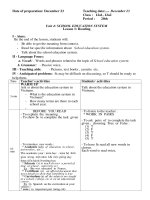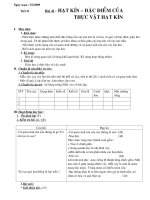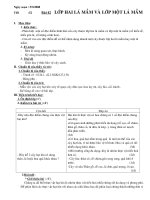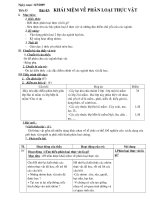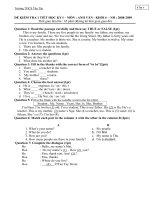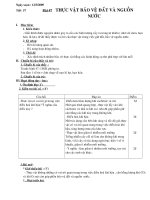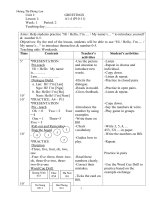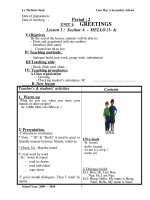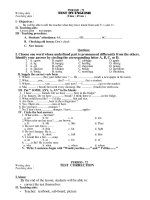GA AV 6 (4 cột-đầy đủ-chi tiết)
Bạn đang xem bản rút gọn của tài liệu. Xem và tải ngay bản đầy đủ của tài liệu tại đây (1.02 MB, 213 trang )
Week: 01 GIỚI THIỆU VÀ HƯỚNG DẪN
Period: 01 HỌC SINH HỌC TIẾNG ANH
Date of preparation:………………. TRUNG HỌC CƠ SỞ
I. GIỚI THIỆU SÁCH GIÁO KHOA TIẾNG ANH 6:
- Tiếng Anh 6 là cuốn sách đầu tiên trong bộ sách tiếng Anh 4 năm cho các trường THCS. Nội dung
gần gủi với cuộc sống, sát thực với mục đích , nhu cầu và hứng thú của các em.
- Tiếng Anh 6 giúp các em bước đầu làm quen với tiếng Anh đồng thời giúp các em có thể nghe, nói
đọc và viết tiếng Anh ở mức độ đơn giản.
- Tiếng Anh 6 có 16 đơn vò bài. Mỗi đơn vò bài gồm 2 đến 3 phần A, B hoặc C. Mỗi phần được học từ 1
đến 2 tiết học 45 phút, gồm các hoạt động sau:
1. Mỗi bài là tranh hoặc các hoạt do giáo viên tiến hành nhằm gây hứng thú và hướng sự chú ý
của cá em vào trọng tâm bài.
2. Fgiới thiệu ngữ liệu mới gồm các mục như: Listen – Repeat / Listen – Read nhằm giới thiệu
những từ và cấu trúc mới trong bối cảnh ngôn ngữ trong đời sống.
3. Kiểm tra mức độ hiểu ngữ liệu mới gồm các mục : Ask – Answer / Practice with a partner /
Match / True – False nhằm giúp các em hiểu thông tin trong bài đọc hoặc bài đối thoại.
4. Thực hành có các loại bài tập khác nhau về nghe, nói, đọc để thực hành ngữ liệu mới.
5. Ghi nhớ (Remember) là mục tóm tắt trọng tâm của bài giúp các em ghi nhớ những điểm
chính của mỗi phấn học.
6. Luyện tập ngữ pháp (Grammar practice) là tập hợp các bài tập thực hành nhằm giúp các em
củng cố thêm các cấu trúc ngữ pháp sau mỗi 2 hoặc 3 đơn vò bài học.
II. CẤU TRÚC CHƯƠNG TRÌNH:
- Gồm có :105 tiết. Mỗi tuần có 3 tiết ( 35 tuần )
- Các loại kiểm tra : + Kiểm tra miệng ít nhất 1 lần.
+ Kiểm tra thường xuyên ít nhất 3 lần / HK.
+ Kiểm tra dònh kì 2 lần / HK.
+ Kiểm tra HK : 2 lần / năm.
III. HƯỚNG DẪN HỌC SINH HỌC BỘ MÔN TIẾNG ANH:
- Nắm bắt ngữ liệu mới: + Từ vựng : Được giáo viên giới thiệu bằng tranh, ảnh hoặc các thủ thuật.Học sinh
tiếp nhận và ghi nhớ. Để có thể đọc và viết được từ học sinh cần học kỉ từ vựng ở nhà (Đọc và viết từ
nhiều lần).
+ Cấu trúc mới : Được rút ra từ các tranh ảnh, mẫu đối thoại hoặc những gợi ý
từ trong thực tế. Từ đó học sinh tự đưa ra cấu trúc qua gợi ý của giáo viên. Học sinh sẽ được luyện tập các cấu trúc
bằng nhiều hoạt động khác nhau nhằm giúp học sinh ghi nhớ và biết vận dụng cấu trúc vừa học.
+ Đọc hiểu : Nhằm rèn luyện kó năng đọc hiểu cho học sinh qua các bước Trước
khi đọc-Trong khi đọc- Sau khi đọc. Trong hoạt động trrước khi đọc, học sinh đọc và đoán nội dung của bài sắp
đọc. Trong khi đọc học sinh sẽ đọc bài đọc và kiểm tra lại ý đoán của mình. Sau đó đọc kỉ lại bài và hoàn thành
các bài tập xoay quanh nội nôi dung bài. Sau khi đọc là bước kiểm tra lại mức độ hiểu và áp dụng của học sinh sau
khi hoàn thành bài đọc.
+ Nghe : Rèn luyện kó năng nghe và cũng được thực hiện theo các bước như đọc
hiểu. Ở lớp 6 học sinh chỉ nghe ở mức độ đơn giản như nhận biết âm, từ hoặc những nội dung đơn giản.
+ Viết : Rèn luyện kó năng viết ở mức độ đơn thuần như thay thế , miêu tả cảnh
vật xung quanh.
Tóm lại để học tiếng Anh đạt hiệu quả học sinh cần chòu khó, tích cực tham gia các hoạt động do giáo
viên yêu cầu.
page 1
Week: 01 UNIT 1: GREETINGS
Period: 02 Lesson 1: HELLO (A1 – A4 )
Date of preparation: ………………..
I. Aim: To teach students “ Hi / Hello” , “ I’m … / My name’s…” to introduce themselves and
numbers 0 – 5.
II. Objective: By the end of the lesson, students may introduce themselves.
III. Teaching aids: Pictures and cards
IV. Procedure:
page 2
page 3
Tim
e
Content Teacher’s activities Students’ activities
3’
1.Revision:
- Should we learn vocabulary?
- How can you learn vocabulary?
-Ask students some questions
about how to study English.
-Answer the teacher’s
questions
10’
2.Presentation:
+Vocabulary:
- Hi / Hello: Chào
- a name: tên
- I : tôi
- My: của tôi
- Am / is / are: là
Elicit vocabulary
• Situation
• Explanation
• Mine
• Translation
• Translation
- Listen to the teacher.
- Give the meaning of the
words.
- Repeat after the teacher.
- Copy down.
+ Checking vocabulary: Rub out and remember
- Point to the Vietnamese
translation and ask “ What’s this
in English?”
- If there is time, get students to
write the English words again.
- Look at the Vietnames
translation and call the
English words.
- Come to the board and
rewrite them in English.
+ Target language:
Form:
- Hello / Hi.
- I am ( ‘m )... / My name is (‘s) …
- Xin chào.
- Tôi là… / Tên của tôi là…
- Dùng khi chào (thân mật) và tự
giới thiệu.
Pictures
- Use pictures to set the scene in
an effort to elicit the target
structures.
- Ask students to say the
greetings how to introduce
themselves.
- Pay attention to what the
teacher shows and listen to
him or her attentively.
- Say the greeting and how to
identify oneself.
10’
3. Practice: A3,4 (page 11)
- I’ am Lan.
- I’ am Nga.
- My name is Ba.
- My name is Nam.
Picture cues
- Run through the pictures .
- Let students play the role of
Lan, Ba, Nga and Ba.
- Listen to them and correct their
mistakes If they don’t pronounce
correctly.
- Look at the pictures.
- Follow the teacher.
- Practice individualy in
pairs, in groups.
- Notice the main tress Hello
(2
nd
syllable).
5’
Numbers:
- Oh: 0
- One: 1
- Two: 2
- Three: 3
- Four: 4
- Five: 5
Mine
//
Translation
- Look at the teacher.
- Listen.
- Repeat individually.
Copy the number in the
notebooks
+ Checking vocabulary:
1 4
3
5
2
Slap the board
- Put the numbers on over the
board
- Call two students or two teams
of students to the front of the
class.
- Call out one of the numbers in
Group works.
- Say the numbers .
- Listen to the numbers.
- Run forward and slap the
correct numbers on the
board.
.............................................................................................................................................................
……………………………………………………………………………………………………………………………………………………………..
……………………………………………………………………………………………………………………………………………………………..
……………………………………………………………………………………………………………………………………………………………..
……………………………………………………………………………………………………………………………………………………………..
……………………………………………………………………………………………………………………………………………………………..
……………………………………………………………………………………………………………………………………………………………..
……………………………………………………………………………………………………………………………………………………………..
……………………………………………………………………………………………………………………………………………………………..
……………………………………………………………………………………………………………………………………………………………..
Week: 01 UNIT 1: GREETINGS
Period: 03 Lesson 2: HELLO (A5 – A8 )
Date of preparation:……………….
I. Aim: Help students ask how people are, say thank you and numbers 0 – 10.
II. Objective: By the end of the lesson, students will be able to use “How are you” and “ I’m
fine thank you” to ask how people are and say thank you.
III. Teaching aids:
III. Procedure:
page 4
page 5
Tim
e
Content Teacher’s activities Students’ activities
5’
1.Revision:
- wto = two
- etrhe = three
- ifve = five
- eno = one
- roze = zero
Jumbled words
-Write numbers whose letters are
in disorder.
- Divide the class into two teams.
- Ask students from each team to
go to the board and write the
correct words .
-Look at the board.
- Listen to the teacher.
- Work in teams.
- Go to the board and write
the correct words. (One
word, one student)
10’
2.Presentation:
+Vocabulary:
- Fine (adj): tốt, khỏe
- Thanks: cảm ơn
- Miss : cô (với tên)
- Mr: ông (với tên)
Elicit vocabulary
• Situation
• Situation
• Translation
• Translation
- Listen to the teacher.
- Give the meaning of the
words.
- Repeat after the teacher.
- Copy down.
+ Checking vocabulary:
Rub out and remember
-Point to the Vietnamese
translations and rub out English
words.
- Get students to call the English
words.
- Students repeat chorally
and remember all the
English words.
- Call the English words and
write the English words if
there is time.
5’
+ Target language:
Ba: Hi, Lan.
Lan: Hello, Ba.
Ba: How are you?
Lan: I’m fine thank you. And you?
Ba: Fine, thank.
- How are you?
- I’m fine. Thanks/ Thank you.
- Bạn có khỏe không?
- Tôi khỏe. Cảm ơn.
-Dùng để hỏi thăm sức khỏe và
nói lời cảm ơn.
Presentation dialogue.
- Ask students to listen to
between Ba and Lan.
- Who are they?
- What does Ba ask? And Lan?
- How can you say them in
Vietnamese?
- What do you use them for?
- Pay attention to what the
teacher shows and listen to
the tape.
- Answer the questions.
- They are Ba and Lan.
- How are you? – I’m fine.
Thanks.
- Ask how people are and
say thanks.
- Write in the notebooks.
15’
3. Practice:
Ba: Hi, Lan.
Lan: Hello, Ba.
Ba: How are you?
Lan: I’m fine thank you. And you?
Ba: Fine, thanks.
Substitution drill
- Get students to repeat the
dialogue.
- Call out the underlined words to
be changed in the dialogue.
- Listen to them and correct their
mistakes If they don’t pronounce
correctly.
- Look at the pictures.
- Repeat after the teacher.
- Make the change and
repeat the new dialogue.
- Pracitce in pairs, use the
name of the people in the
pictures.
5’
Numbers: 6 - 10
- Six 9
- Seven 7
- Eight 10
- Nine 6
- Ten 8
Matching
- Write the words in a list and the
numbers in wrong order.
- Get students to come to the
board to match the words with
the numbers.
- Correct.
- Listen to the teacher.
- Go to the board to match
the words with the
numbers.Listen.
- Read the numbers.
- Copy the number in the
notebooks
7’
4.Further practice: Dictation
.............................................................................................................................................................
……………………………………………………………………………………………………………………………………………………………..
……………………………………………………………………………………………………………………………………………………………..
……………………………………………………………………………………………………………………………………………………………..
……………………………………………………………………………………………………………………………………………………………..
……………………………………………………………………………………………………………………………………………………………..
……………………………………………………………………………………………………………………………………………………………..
……………………………………………………………………………………………………………………………………………………………..
Week: 02 UNIT 1: GREETINGS
Period: 04 Lesson 3: GOOD MORNING (B1 – B6 )
Date of preparation:……………..
I. Aim: Help students to learn how to greet people (in the morning, in the afternoon, in the
evening) to say goodbye, to count from 11 to 15.
II. Objective: By the end of the lesson, students will be able to use the expressions above to
greet people and to say goodbye.
III. Teaching aids: Poster and pictures
IV. Procedure:
page 6
page 7
Tim
e
Content Teacher’s activities Students’ activities
5’
1.Revision:
7 2 6 2 1
3 8 5 10 9
Bingo
-Put the numbers on the board.
-Ask students to choose any five
numbers and copy them into their
books.
- Read out the numbers in any
order.
-Look at the board.
- Listen to the teacher.
- Choose any five numbers.
- Put ticks next to the
numbers that the teacher
reads.
- Shouts “Bingo”.
10’
2.Presentation:
+Vocabulary:
- Good morning: chào (buổi sáng) -
Good afternoon: chào(buổi chiều)
- Good evening: chào (buổi tối)
- Good night: chúc ngủ ngon
- Goodbye: tạm biệt
- Children: những đứa trẻ.
Elicit vocabulary
- Say the greetings and have
students repeat.
- Emphasize the main stress in
the greetings.
- Ask students to say translations.
- Listen to the teacher.
- Repeat.
- Notice the main stress
pattern.
- Copy the new words in the
notebooks .
+ Checking vocabulary:
Good afternoon
Good morning
Good evening
Good evening
Good night
Goodbye
What and where
- Elicit the vocabulary from the
students and write them in the
circles.
- Get students to repeat the words
including the rubbed out words
by pointing at the empty circle.
- Students repeat chorally
and remember all the words.
- Go to the board and fill in
the circles with the right
words.
5’
+ Target language:
Miss Hoa: Good morning, children.
Children: Good morning, Miss Hoa
Miss Hoa: How are you?
Children: We’re fine, thank you.
How are you ?
Miss Hoa: Fine, thank. Goodbye.
Children: Bye.
- Good morning.
- We’re fine. Thank you.
- Goodbye / Bye.
- Chào
- Chúng tôi / em khỏe. Cảm ơn.
-Dùng để chào hỏi mang tính trang
trọng, lòch sự và phân biệt thời điểm
trong ngày.
Rub out and remember
dialogue.
- Put the dialogue on the board
-Set the scene to introduce the
greetings.
- Who are they?
- What are they doing?
- Read the dialogue and rub out
some of the words.
- Rub out all of the words.
- Ask student some questions.
- How does Miss Hoa greet the
children? What about the
children?
- What does Miss Hoa do?
- What do the children do?
- What do they say at the end?
- Pay attention to the teacher
and answer the questions.
- They are Miss Hoa and
children.
- They are greeting together.
- Practice saying it and have
to remember the rubbed out
words
- Repeat the rubbed out
dialogue from memory.
- Good morning, children.
- Good morning, Miss Hoa.
- She is a teacher.
- They are students.
- Goodbye – Bye.
10’
3. Practice: B2 (page 15)
- Good morning
- Good afternoon
- Good evening
- Good night
Picture drill
- Run through the pictures.
- Let students identify the
differences between the pictures.
- When is the first /……… picture?
- How can you greet people in
the morning?
- Ask them to practice in pairs
and in groups.
- Look at the pictures.
- Repeat after the teacher.
- Answer the questions.
- In the morning/ afternoon …
- Good morning.
- Pracitce greeting and
saying goodbye in pairs then
in groups.
Week: 02 UNIT 1: GREETINGS
Period: 05 Lesson 4: HOW OLD ARE YOU? (C1 – C4 )
Date of preparation:……………….
I. Aim: “How are you” to talk about age and numbers 16 – 20.
II. Objective: At the end, students will be able to say how old one is, to ask how old others
are and to count from 16 to 20.
III. Teaching aids: Pictures and poster
IV. Procedure:
page 8
page 9
Tim
e
Content Teacher’s activities Students’ activities
5’
1.Revision:
- Good morning - Good night
- Good afternoon - Goodbye
- Good evening
- Call two students to the front of
the class and say the greetings.
- Read the numbers: 13, 15, 11,
12,.
- Say the greetings and
goodbye.
- Write the numbers in
English.
10’
2.Presentation:
+Vocabulary:
- Sixteen = 16
- Seventeen = 17
- Eighteen = 18
- Nineteen = 19
- Twenty = 20
Elicit vocabulary
• Picture
• //
• //
• //
• //
- Listen to the teacher.
- Say the numbers in English
- Repeat after the teacher.
- Notice the main stress
- Write the new words in
their notebooks.
+ Checking vocabulary:
19 16
17
20
18
Slap the board
- Put the numbers on over the
board
- Call two students or two teams
of students to the front of the
class.
- Call out one of the numbers in
English in loud voice.
Group works.
- Say the numbers .
- Listen to the numbers.
- Run forward and slap the
correct numbers on the
board.
5’
+ Target language:
- C3 (page 18)
- How old are you?
- I’m (am) ……… years old.
- Bạn bao nhiêu tuổi?
- Tôi ……………… tuổi.
- Hỏi tuổi người khác và trả lời.
Presentation dialogue.
- Set the scene in which there are
three people.
- Ask students to listen to the
tape and repeat.
+ What does Miss Hoa ask
Lan?
+ What does it used for?
- Pay attention to what the
teacher shows and listen to
the tape.
- Repeat after the teacher.
- Answer the questions.
- How old are you?.
- Ask how old others are.
15’
3. Practice:
Nam: Hi, Ba.
This is Phong
Ba: Hi, Phong.
How old are you?
Phong: I’m twelve.
Substitution drill
- Get students to repeat the
dialogue.
- Call out the underlined words to
be changed in the dialogue.
- Listen to them and correct their
mistakes.
- Look at the pictures.
- Repeat after the teacher.
- Make the change and
repeat the new dialogue.
- Pracitce in pairs, use the
name of the people in the
pictures.
7’
4.Further practice:
Play role
- Divide the class into small
groups of three students.
- Let them play the roles.
- Ask some students about their
ages.
- Work in small groups of
three students.
- Play the roles.
- Answer about their ages .
- Copy down the dialogue
(C3).
3’
5.Homework:
- Numbers 0 -20
- How old are you?
- I’m ……………… years old.
- Unit1: Greetings – Lesson 5 (C5-C6
).
- Ask students to learn how to ask
how old people are, numbers 0 –
20
- Have them and prepare Lesson
5 ( C5-C6):Further Practice in
- Take notes.
- Do homework as directed.
.............................................................................................................................................................
……………………………………………………………………………………………………………………………………………………………..
……………………………………………………………………………………………………………………………………………………………..
……………………………………………………………………………………………………………………………………………………………..
……………………………………………………………………………………………………………………………………………………………..
……………………………………………………………………………………………………………………………………………………………..
……………………………………………………………………………………………………………………………………………………………..
……………………………………………………………………………………………………………………………………………………………..
……………………………………………………………………………………………………………………………………………………………..
……………………………………………………………………………………………………………………………………………………………..
Week: 02 UNIT 1: GREETINGS
Period: 06 Lesson 5: HOW OLD ARE YOU (C5 – C6 )
Date of preparation:……………….
I. Aim: Further practice in number 0 – 20 to count and give telephone numbers .
II. Objective: At the end, students will be able to use numbers fluently.
III. Teaching aids: Cards
IV. Procedure:
page 10
.............................................................................................................................................................
……………………………………………………………………………………………………………………………………………………………..
……………………………………………………………………………………………………………………………………………………………..
……………………………………………………………………………………………………………………………………………………………..
……………………………………………………………………………………………………………………………………………………………..
page 11
Tim
e
Content Teacher’s activities Students’ activities
5’
1.Warm up:
7, 19, 15, 20, 6, 13, 8,
10, 1, 4, 11, 14, 2, 0,
3, 16,5, 17,12, 18,9.
Bingo
- Put the numbers on the board.
-Ask students to choose any five
numbers and copy them into their
books.
- Read out the numbers in any
order.
-Look at the board.
- Listen to the teacher.
- Choose any five numbers.
- Put ticks next to the
numbers that the teacher
reads.
- Shouts “Bingo”.
10’
2. Practice:
- tgieh = eight
- trentieth = thirteen
- lewtev = twelve
- ytwnet = twenty
- nternouf = fourteen
- eevsn = seven
- ientenen = nineteen
Jumbled words
-Write numbers whose letters are
in disorder.
- Divide the class into two teams.
- Ask students from each team to
go to the board and write the
correct words .
-Look at the board.
- Listen to the teacher.
- Work in teams.
- Go to the board and write
the correct words. (One
word, one student).
10’ 04 821 4076 054 845 832
091 34 33565 5511 82 66 99
08 557 1313 071 839 737
033 612 300 0240 853 199
Dictation and picture cue drill
- Write the numbers on the
board.
- Ask students copy any numbers
in their notebooks
- Do the modelsentences:
S1: What’s your numbers?
S2: 0h-seven-eight-three-nine
- Look at the board.
- Copy any numbers in their
notebooks.
- Listen to the teacher.
- Work in pairs.
- Some pairs practice in
front.
15’
3.Production:
Name Telephone numbers
1. Hoa
2. …………
3. …………
4. …………
033 612 300
………………………
………………………
………………………
Survey
- Write the table on the board.
- Ask students some questions :
+ What is this? And this?
- Example exchange:
+ What’s your name? Hoa
+What’ your numbers?
- Look at the board.
- Answer the questions:
- Name – Telephone
numbers.
- Practice in pairs.
- Ask and take notes.
- Retell.
5’
4.Homework:
- Numbers 0 -20
- Exercises in the exercise book from
page 5-9.
- Unit2: Greetings – Lesson 1 (A1-
A4 ).
- Ask students to learn how to
numbers 0 –20
- Have them do copy down the
dialogue and the exercises in the
exercise book and prepare Unit2:
Come in – Lesson 1 (A1-A4).
- Memorize the greetings.
- Do homework as directed.
……………………………………………………………………………………………………………………………………………………………..
……………………………………………………………………………………………………………………………………………………………..
……………………………………………………………………………………………………………………………………………………………..
……………………………………………………………………………………………………………………………………………………………..
……………………………………………………………………………………………………………………………………………………………..
Week: 03 UNIT 2: AT SCHOOL
Period: 07 Lesson 1: COME IN (A1 – A4 )
Date of preparation:……………..
I. Aim: Students learn how to use simple commands in class.
II. Objective: By the end of the lesson students will be able to understand the teacher’s
Commands.
III. Teaching aids: Poster
IV. Procedure:
page 12
page 13
Tim
e
Content Teacher’s activities Students’ activities
5’
1.Warm up:
9 + 1 13 + 7 10 + 2
17 + 1 6 + 5 8 + 4
3 + 8 6 + 10 5 + 3
Nought and crosses
- Put the grid on the board.
- Divide class into teams. One is
noughts (O) and the other is
Crosses (X).
- Two teams choose any numbers
in the boxes and say the numbers
in English.
- The team which has three
noughts or three crosses on a line
will win the game.
- Look at the board.
- Work in groups.
- One is noughts (O) and the
other is Crosses (X).
- Choose any numbers in the
boxes and say the numbers
in English.
* Team A:
- Student 1: Ten and Two?
- Student 2: Twelve
10’
2.Presentation:
+Vocabulary:
- ( to ) come in : đi vào.
- ( to ) sit down : ngồi xuống.
- ( to ) stand up : đứng lên.
- ( to ) open your book : mở sách.
- ( to) close your book: đóng sách
Elicit vocabulary
• Visual
• Mine
• Antonym
• Mime
• Antonym
- Listen to the teacher.
- Say the commands in
English
- Repeat after the teacher.
- Notice the pronunciation.
- Write the new words in
their notebooks.
+ Checking vocabulary:
đứng lên
đi vào
đóng sách
mở sách
ngồi xuống
Slap the board
- Put the Vietnamese translation
of the new words on the board.
- Call two students of two teams
to the front of the class.
- Call out one of the commands
in English in loud voice.
Group works.
- Say the Vietnamese words .
- Listen to the teacher.
- Run forward and slap the
correct commands on the
board.
- Continue until students
have slapped all the words.
3’
+ Target language: - A1 (P. 20)
- Come in.
- Sit down / Stand up.
- Open / Close your book.
- Đi vào.
- Ngồi xuống / Đứng lên.
- Mở sách / Đóng sách.
- Ra lệnh cho người khác .
Presentation pictures.
- Set the scene, introduce the
commands, using pictures.
- Let students repeat after the
teacher.
+ What is the teacher doing?
+ What does she say?
+ What does it used for?
- Listen to the teacher
without opening the books.
- Look at the pictures and
repeat after the teacher.
- Answer the questions.
- Come in.
- To give a command.
15’
3. Practice:
- A2 - 3 (page 21, 22)
a) Open your book.
b) Sit down.
c) Come in.
d) Close your book.
e) Stand up.
Matching
- Ask studnets to match up the
commands with appropriate
pictures.
Simon says
- Let them practice the
commands together.
- Let them play game: “Simon
says”
- Read the commandans.
- Match up the commands
with appropriate pictures.
- Practice in pairs.
- Play games.
+ S1: Simon says: Stand
up.
+ S2: Stand up.
9’
4.Further practice:
Miss Hoa
Children
………… morning!
How ………………?
.. morning,M.H !
We’re … How…?
Mapped dialogue
- Put the dialogue on the board
which is only words. The words
are cues.
- Model the dialogue.
- Look at the board and listen
to the teacher.
- Repeat after the teacher.
- Practice the dialogue in
.............................................................................................................................................................
……………………………………………………………………………………………………………………………………………………………..
……………………………………………………………………………………………………………………………………………………………..
……………………………………………………………………………………………………………………………………………………………..
……………………………………………………………………………………………………………………………………………………………..
……………………………………………………………………………………………………………………………………………………………..
……………………………………………………………………………………………………………………………………………………………..
……………………………………………………………………………………………………………………………………………………………..
……………………………………………………………………………………………………………………………………………………………..
……………………………………………………………………………………………………………………………………………………………..
Week: 03 UNIT 2: AT SCHOOL
Period: 08 Lesson 2: WHERE DO YOU LIVE? (B1 – B2)
Date of preparation:……………….
I. Aim: Students learn how to ask and answer about where they live.
II. Objective: By the end of the lesson, students will be able to use “ Where do you live?”
questions to talk about the places they live.
III. Teaching aids: Cards
IV. Procedure:
page 14
page 15
Tim
e
Content Teacher’s activities Students’ activities
5’
1.Warm up:
- Sit down.
- Stand up.
- Come in.
- Open your book.
- Close your book.
Simon says
- Simon says: “Stand up”
“Sit down”
- “Open your book”
- Simon says “Open your book”
- Simon says “Close your book”
- Play games.
- Stand up.
- Sit down.
- X.
- Open their books.
- Close their books
10’
2.Presentation:
+Vocabulary:
- ( to ) live : sống
- ( in ) a house : (trong) căn nhà.
- ( on ) a treet : (trên) đường phố.
- ( in ) a city : (ở) thành phố.
Elicit vocabulary
• Tranlation
• Drawing
• Visual
• Picture
- Listen to the teacher.
- Answer the T’s questions.
- Repeat after the teacher.
- Notice the main stress
pattern.
- Write the new words in
their notebooks.
+ Checking vocabulary:
live Huế
city
street sống
house
Matching
- Put the Vietnamese translation,
English words and pictures on the
board.
-Ask students to match English
words with the Vietnamese
translation and pictures.
Group works.
- Lookl at the board.
- Listen to the teacher.
- Work in teams.
- Come to the board and
match English words with the
Vietnamese translation and
pictures.
5’
+ Target language: - B1 (Page. 23)
Mai: What’s your name?
Nam: My name’s Nam.
Mai: Where do you live?
Nam: I live on Tran Phu Street.
Mai: How old are you?
Nam: I’m twelve years old.
- Where do you live?
- I live in / on …………
- Bạn sống ở đâu?
- Tôi sống ở …………
- Hỏi nơi sống của người khác.
Presentation pictures.
- Show students, places and the
conversation they have in the
pictures.
- Let them listen to the cassette.
- Let students repeat after the
teacher.
-Get students to isolate the model
sentence.
- Ask students to pay attention to
the pronunciation, the linking
sounds:
* I live in …………….
- Look at the pictures and
listen to the teacher’s
explanation.
- Listen to the cassette and
repeat as the teacher aked.
-Repeat after the teacher.
- Isolate the model sentence
by reading aloud the
underlined sentence.
- Pay attention to the
pronunciation, the linking
sounds
* I live in …………….
15’
3. Practice:
a house Lê Lợi Street
Hà Nội HCMC
Hùng Vương St a city
Word cues
- Run through the words.
- Hold up the first cue and say
the model sentences.
- Do the same for the seccond
cue.
- Elicit the sentence by holding
up the cue.
- Correct their mistakes.
- Look at the cues.
- Listen to the teacher.
- Repeat it chorally and then
individually.
- Make the sentence for
themselves.
- Practice in pairs.
- Some pairs practice in
front.
7’
4.Further practice:
Name Street City
Survey
- Have students look at the table
on the board.
- Look at the board and listen
to the teacher.
……………………………………………………………………………………………………………………………………………………………..
……………………………………………………………………………………………………………………………………………………………..
……………………………………………………………………………………………………………………………………………………………..
…………………………………………………………………………………………………………………………………………………………….
……………………………………………………………………………………………………………………………………………………………..
……………………………………………………………………………………………………………………………………………………………..
……………………………………………………………………………………………………………………………………………………………..
……………………………………………………………………………………………………………………………………………………………..
……………………………………………………………………………………………………………………………………………………………..
……………………………………………………………………………………………………………………………………………………………..
……………………………………………………………………………………………………………………………………………………………..
……………………………………………………………………………………………………………………………………………………………..
Week: 03 UNIT 2: AT SCHOOL
Period: 09 Lesson 3: WHERE DO YOU LIVE? (B3 – B4)
Date of preparation:………………..
I. Aim: Students learn how to talk about their names, and how to spell their names .
II. Objective: By the end of the lesson, students will be able to use “ What’ s your names?”
and “How do you spell it?” questions to talk about their names.
III. Teaching aids: Poster and pictures
IV. Procedure:
page 16
page 17
Tim
e
Content Teacher’s activities Students’ activities
5’
1.Warm up:
a house
Lạch
Tray St
Tràng
Tiền
a street Đà Nẳng a city
Đồng
Hới
Hàng
Bông St
Long
Xuyên
Nought and crosses
- Put the grid on the board.
- Divide class into teams. One is
noughts (O) and the other is
Crosses (X).
- Two teams choose any places in
the boxes, ask and answer about
their places :
+ Where do you live?
+ I live in / on ……………
- The team which has three
noughts or three crosses on a line
will win the game.
- Look at the board.
- Work in groups.
- One is noughts (O) and the
other is Crosses (X).
- Choose any places in the
boxes, ask and answer about
their places :.
* Team A:
- Student 1: Where do you
live?
- Student 2: I live in / on
…………
6’
2.Presentation:
+Vocabulary:
- ( to ) spell : đánh vần
- How : bằng cách nào.
- Name : tên
Elicit vocabulary
• Mine
• Translation
• Explanation
- Listen to the teacher.
- Repeat after the teacher.
- Write the new words in
their notebooks.
+ Checking vocabulary:
name
How
spell
What and where
- Elicit the vocabulary from the
students and write them in the
circles.
- Get students to repeat the words
including the rubbed out words
by pointing at the empty circle.
- Students repeat chorally
and remember all the words.
- Go to the board and fill in
the circles with the right
words.
5’
4’
+ Target language: - B4 (Page. 25)
Teacher: What’s your name?
Lan: My name’s Lan.
Teacher: How do you spell it?
Lan: L – A – N, Lan.
- What’s your name?
- My name’s …………
- How do you spell it?
- Tên bạn là gì?
- Tên tôi tên là …………
- Bạn đánh vần tên bạn như thế
nào?
- Hỏi tên và trả lời.
+ B3 ( Page 24 )
A B C D E F
G H I J K L
M N O P Q R
S T U V W X
Y Z
Presentation pictures.
- Show students the picture and
the conversation they have in the
picture.
- Let them listen to the cassette.
- Let students repeat after the
teacher.
-Get students to isolate the model
sentence.
- What does the teacher ask Lan?
- How does Lan answer?
- What does She ask then?
- Introduce the letters from A to
Z
- Mark the 4 letters that don’t
have exist in the Vietnamese
alphabet f, j, w, z; and the
differences of the two English
letters [ e, i ] in pronouncing.
- Let them to repeat letters and
then write.
- Look at the pictures and
listen to the teacher’s
explanation.
- Listen to the cassette and
repeat as the teacher aked.
-Repeat after the teacher.
- Isolate the model sentence
by reading aloud the
underlined sentence.
- What’s your name?
- My name’s Lan.
How do you spell it?
- Listen to the teacher.
- Pay attention to the four
new letters f, j, w and z.
- Listen and repeat after the
teacher.
- Say the letters individually.
- Write the letters in the
notebooks.
15’
3. Practice: Word cues
Week: 04 UNIT 2: AT SCHOOL
Period: 10 Lesson 4: WHERE DO YOU LIVE? (B5 – B6)
Date of preparation:……………….
I. Aim: Further practice in personal information, alphabet and numbers.
II. Objective: By the end of the lesson, students will be able to use numbers, personal
information and alphabet more fluently.
III. Teaching aids: Poster
III. Procedure:
page 18
page 19
Tim
e
Content Teacher’s activities Students’ activities
5’
1.Warm up:
e
i y
u g
o j
h
f
l k
Slap the board
- Put the letters on the board.
- Call two students of two teams
to the front of the class.
- Call out one of the letters in
English in loud voice.
Group works.
- Look at the board .
- Listen to the teacher.
- Run forward and slap the
correct letters on the board.
- Continue until students
have slapped all the letters.
10’
2.Presentation: B5 (page 25)
a. My name is Lan.
b. I am eleven years old.
c. I live on Le Loi street.
d. L – A – N, Lan.
Answer given
- Show students the statements.
- Let students ask question to
get information about Lan.
-Correct if there are any
mistakes
- Look at the board.
- Read the statements.
- Ask question to get
information about Lan.
10
3. Practice:
1 2 3 4 5
6 7 8 9 10
1. How old are you?
2. Lucky number.
3. Where do you live?
4. What’ s your name?
5. Lucky number.
6. How do you spell your name?
7. What’s your city’s name?
8. Lucky number.
9. What’s your street’s name?
10. How are you?
Lucky numbers
- Write the numbers on the
board.
- Divide class into teams. The
teams take turn to choose the
numbers.
- Tell students that they have to
answer questions about personal
information .
- Look at the board.
- Work in teams.
- Take turn to choose the
numbers.
- Answer the questions about
personal information.
15’
4.Further practice:
Lan 12 Le Loi St
H-O-A-I
Fine,
thanks
13
Hueá Thöông Vietnam
Nought and crosses
- Put the grid on the board.
- Divide class into teams. One is
noughts (O) and the other is
Crosses (X).
- Two teams choose any ones in
the boxes and ask questions
about personal information .
- The team which has three
noughts or three crosses on a line
will win the game.
- Look at the board.
- Work in groups.
- One is noughts (O) and the
other is Crosses (X).
- Choose any ones in the
boxes, ask and ask questions
about personal information.
- Congratulate.
5’
5.Homework:
- Vocabulary ( A and B)
- Personal information.
- Exercises in the exercise book
from page 10 to 12.
- Unit2: My School - Lesson 5(C1).
- Ask students to learn
Vocabulary and personal
information.
- Have them do some exercises
in the exercise book from page
10 to 12 and prepare Lesson 5
- Take notes.
- Do as the teacher requests.
……………………………………………………………………………………………………………………………………………………………..
……………………………………………………………………………………………………………………………………………………………..
……………………………………………………………………………………………………………………………………………………………..
…………………………………………………………………………………………………………………………………………………………….
……………………………………………………………………………………………………………………………………………………………..
……………………………………………………………………………………………………………………………………………………………..
……………………………………………………………………………………………………………………………………………………………..
……………………………………………………………………………………………………………………………………………………………..
……………………………………………………………………………………………………………………………………………………………..
……………………………………………………………………………………………………………………………………………………………..
……………………………………………………………………………………………………………………………………………………………..
Week: 04 UNIT 2: AT SCHOOL
Period: 11 Lesson 5: MY SCHOOL (C1)
Date of preparation:………………..
I. Aim: Students learn “This / That” positive statements and “Yes / No” questions.
II. Objective: By the end of the lesson, students will be able to use “ This / That” to make
positive statements and ask “Yes / No” questions.
III. Teaching aids: Pictures
IV. Procedure:
page 20
page 21
Tim
e
Content Teacher’s activities Students’ activities
5’
1. Revision:
- lleho = hello
- mnae = name
- treste = street
- yict = city
- pesll = spell
Jumbled words
-Write numbers whose letters are
in disorder.
- Divide the class into two teams.
- Ask students from each team to
go to the board and write the
correct words .
-Look at the board.
- Listen to the teacher.
- Work in teams.
- Go to the board and write
the correct words. (One
word, one student).
10’
2.Presentation:
+Vocabulary:
- a student : học sinh
- a school : trường.
- a teacher : giáo viên.
- a desk : bàn học.
Elicit vocabulary
• Visual
• Situation
• Picture
• Realia
- Listen to the teacher.
- Answer the T’s questions.
- Repeat after the teacher.
- Notice the main stress
pattern.
- Write the new words in
their notebooks.
+ Checking vocabulary:
Rub out and remember
-Point to the Vietnamese
translations and rub out English
words.
- Get students to call the English
words.
- Students repeat chorally
and remember all the English
words.
- Call the English words and
write the English words if
there is time.
5’
+ Target language: C1(page.
26,27)
- This is my school.
- That’s my class.
- Is that your teacher?
- Is this your desk?
- This is my ………….
- That’s my …………..
- Is that your ……………?
- Is this your ……………?
- Yes, it is.
- No, it isn’t.
- Đây là ……………… .
- Kia là ………………….
- Có phải đây / kia là …………
không?
- Vâng, phải. / Không, không phải.
Presentation pictures.
- Set the scene, introduce new
structures, using pictures.
- Let students repeat after the
teacher.
+ What does he do?
+ Is it his school?
+ What does he say?
- Let them pay attention to the
pronunciations of THIS and
THAT.
- Explain how to use THIS and
THAT.
- Emphasize on the intonation of
the YES - NO questions.
- Look at the pictures and
listen to the teacher’s
explanation.
-Repeat after the teacher.
- Isolate the model sentence
by answer the teacher’s
questions.
- Pay attention to the
pronunciation of THIS and
THAT.
- Listen to the teacher’s
explanation.
- Notice the intonation.
- Rising tone in YES - NO
question.
- Falling tone in answers
15’
3. Practice :
- Pictures on page 25 – 26.
Picture drill
- Run through the pictures.
- Hold up the first picture and say
the model sentences.
- Do the same for the seccond
picture.
- Elicit the sentence by holding
up the picture.
- Correct their mistakes.
- Look at the cues.
- Listen to the teacher.
- Repeat it chorally and then
individually.
- Make the sentence for
themselves.
- Practice in pairs.
- Some pairs practice in
front.
7’
4.Further practice:
- This is my ……………….
- That’s my ……………….
Real things
- Have students practice in pairs
or small groups, using real things
- Practice in pairs or in small
groups.
……………………………………………………………………………………………………………………………………………………………..
……………………………………………………………………………………………………………………………………………………………..
……………………………………………………………………………………………………………………………………………………………..
…………………………………………………………………………………………………………………………………………………………….
……………………………………………………………………………………………………………………………………………………………..
……………………………………………………………………………………………………………………………………………………………..
……………………………………………………………………………………………………………………………………………………………..
……………………………………………………………………………………………………………………………………………………………..
……………………………………………………………………………………………………………………………………………………………..
……………………………………………………………………………………………………………………………………………………………..
……………………………………………………………………………………………………………………………………………………………..
Week: 04 UNIT 2: AT SCHOOL
Period: 12 Lesson 6: MY SCHOOL (C2 – C4)
Date of preparation:………………
I. Aim: Students learn how to say what things are, to ask and answer about things .
II. Objective: At the end, students will be able to use “ This / That” to say what things are, to
ask and answer about things.
III. Teaching aids: Poster and pictures
III. Procedure:
page 22
page 23
Tim
e
Content Teacher’s activities Students’ activities
5’
1. Revision:
a slass
a student
a desk
a school a teacher
What and where
- Elicit the vocabulary from the
students and write them in the
circles.
- Get students to repeat the words
including the rubbed out words
by pointing at the empty circle.
- Students repeat chorally
and remember all the words.
- Go to the board and fill in
the circles with the right
words.
10’
2.Presentation:
+Vocabulary:
- a door : cửa cái.
- a window : cửa sổ.
- a board : tấm bảng.
- a waste basket : giỏ rác.
- a school bag : cặp đi học.
- a pencil : bút chì.
- a pen : bút mựt.
- a ruler : cây thước.
- an eraser : hòn tẩy.
Elicit vocabulary
• Realia
• Realia
• Realia
• Situation
• Realia
• Realia
• Realia
• Realia
• Realia
- Listen to the teacher.
- Answer the T’s questions.
- Repeat after the teacher.
- Notice the main stress
pattern.
- Write the new words in
their notebooks.
+ Checking vocabulary:
a school bag, an eraser, a window,
a pen, a board, a door, a pencil, a
waste bastket, a ruler.
Ordering
- Write the new words on the
board.
- Get students to copy the words
in their books.
- Read the new words.
- Get students to put the words in
the correct order by numbering
them.
Group works.
- Lookl at the board.
- Listen to the teacher.
- Copy the words in the
books.
- Listen and put the words in
the correct order by
numbering them .
5’
+ Target language: C1(page.
26,27)
Nam: Good morning , Mai.
Mai: Good morning, Nam .
How are you?.
Nam: I’m fine, Thanks . And you?
Lan: Fine,Thanks.Oh.What is this?
Nam: It’s a pen.
- What is this / that ?
- It is a / an ………………..
- Đây / kia là cái gì?
- Nó là ………………………
Dialogue build.
- Set the scene.
- Read the dialogue and write
few key words on the board to
help students remember what the
two speaker in the dialogue say
to each other .
- Get students to write in the
missing words on the board.
- Get students to isolate the
model sentence.
-Answer the teacher’s
question.
- Look at the board and listen
to the teacher carefully.
- Reproduce the dialogue
from the cues.
- Build the dialogue until it is
memorized.
- Write in the missing words
on the board.
15’
3. Practice :
- Pictures on page 28 – 29.
- a door - a window.
- a board - a pencil.
- a clock - a pen .
- a ruler - an eraser .
Picture drill
- Run through the pictures.
- Hold up the first picture and say
the model sentences.
- Do the same for the seccond
picture.
- Elicit the sentence by holding
- Look at the cues.
- Listen to the teacher.
- Repeat it chorally and then
individually.
- Make the sentence for
themselves.
- Practice in pairs.
……………………………………………………………………………………………………………………………………………………………..
……………………………………………………………………………………………………………………………………………………………..
……………………………………………………………………………………………………………………………………………………………..
…………………………………………………………………………………………………………………………………………………………….
……………………………………………………………………………………………………………………………………………………………..
……………………………………………………………………………………………………………………………………………………………..
Week: 05 UNIT 3: AT HOME
Period: 13 Lesson 1: MY HOUSE (A1 – A2)
Date of preparation:……………….
I. Aim: Hepl students know “WH – question” with these / those.
II. Objective: At the end, students will be able to use “WH – question” with these / those to
ask and answer about things.
III. Teaching aids: Pictures
IV. Procedure:
page 24
page 25
Tim
e
Content Teacher’s activities Students’ activities
5’
1.Warm up:
a school bag, an eraser, a window,
a pen, a board, a door, a pencil, a
waste bastket, a ruler.
Bingo
- Put the things on the board.
-Ask students to choose any five
things and copy them into their
books.
- Read out the things in any
order.
-Look at the board.
- Listen to the teacher.
- Choose any five things.
- Put ticks next to the things
that the teacher reads.
- Shouts “Bingo”.
10’
2 .Presentation: +Vocabulary:
ghế tựa a lamp
a bookshelf đèn
cái bàn a chair
a couch ghế đẩu
giá sách an armchair
a table ghế sa- lông
ghế bành a tool dài
Matching
- Put the Vietnamese translation
and English words on the board.
-Ask students to match English
words with the Vietnamese
translation .
- Ask students to work in teams.
Group works.
- Lookl at the board.
- Listen to the teacher.
- Work in teams.
- Come to the board and
match English words with
the Vietnamese translation.
+ Checking vocabulary:
Rub out and remember
-Point to the Vietnamese
translations and rub out English
words.
- Get students to call the English
words.
- Students repeat chorally
and remember all the
English words.
- Call the English words and
write the English words if
there is time.
5’
+ Target language: A2 (page 31)
- What are these / those?
- They are desks / windows.
- What are these / those ?
- They are………………..
- Đây / kia là những cái gì?
- Chúng là ………………………
Real things
- Show students the real things
to introduce the new tructures:
+ What is this?
+ What is that?
+ What are these?
+ What are those?
- Look at the things.
-Answer the teacher’s
question.
+ It is a table.
+ It is a board.
+ They are desks
+ They are windows.
15’
3. Practice :
- Pictures on page 31.
- a window - a lamp.
- a door - a stereo.
- chairs - a couch .
- a television - tools .
Picture drill
- Run through the pictures.
- Hold up the first picture and say
the model sentences.
- Do the same for the seccond
picture.
- Elicit the sentence by holding
up the picture.
- Correct their mistakes.
- Look at the cues.
- Listen to the teacher.
- Repeat it chorally and then
individually.
- Make the sentence for
themselves.
- Practice in pairs.
- Some pairs practice in
front.
7’
4.Further practice:
clocks chairs lamp
table door armchairs
Nought and crosses
- Put the grid on the board.
- Divide class into teams. One is
noughts (O) and the other is
Crosses (X).
- Two teams choose any things in
the boxes and ask questions
about what things are .
- The team which has three
noughts or three crosses on a line
- Look at the board.
- Work in groups.
- One is noughts (O) and the
other is Crosses (X).
- Choose any things in the
boxes, ask and ask questions
about what things are.
- Congratulate.
